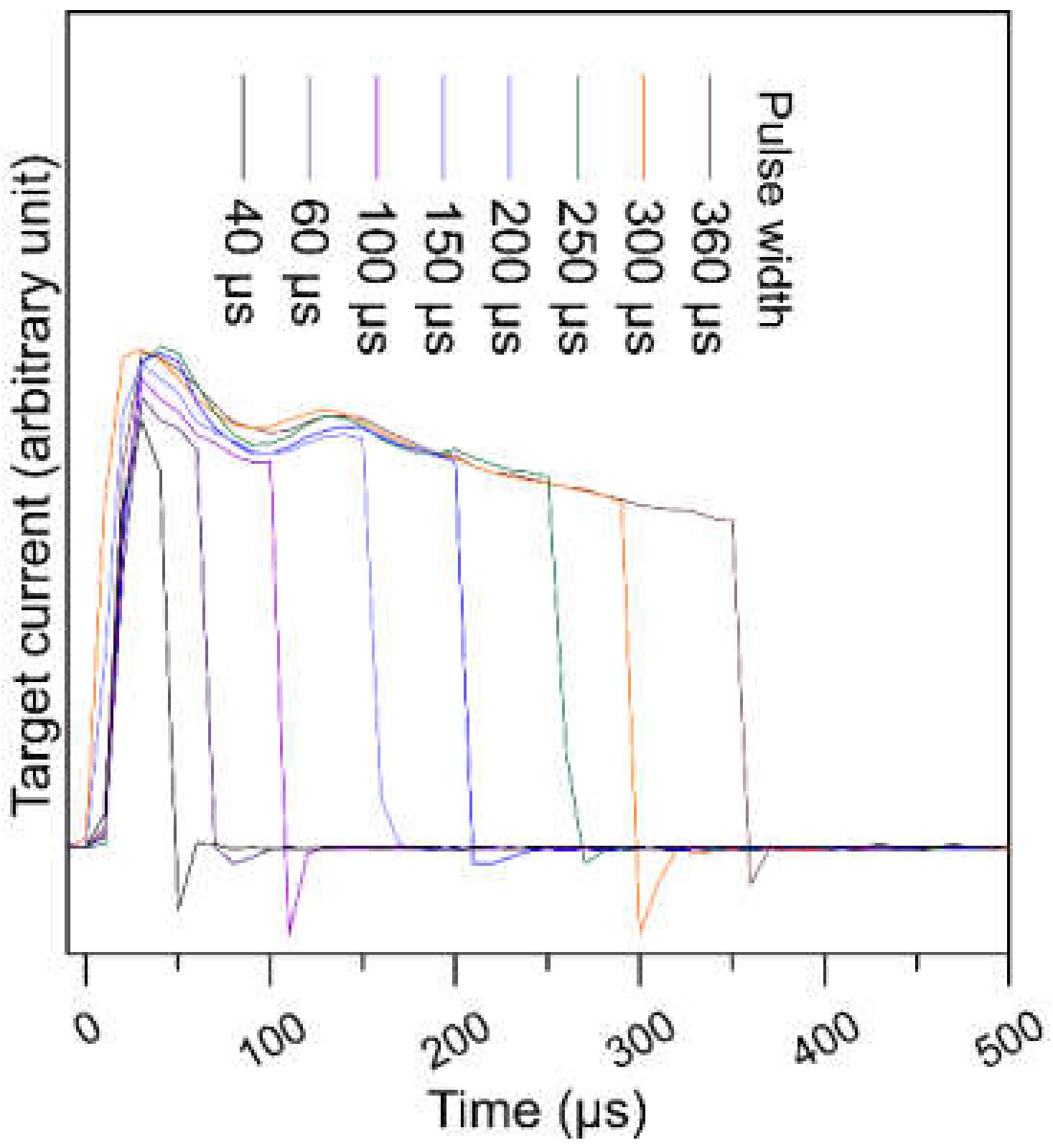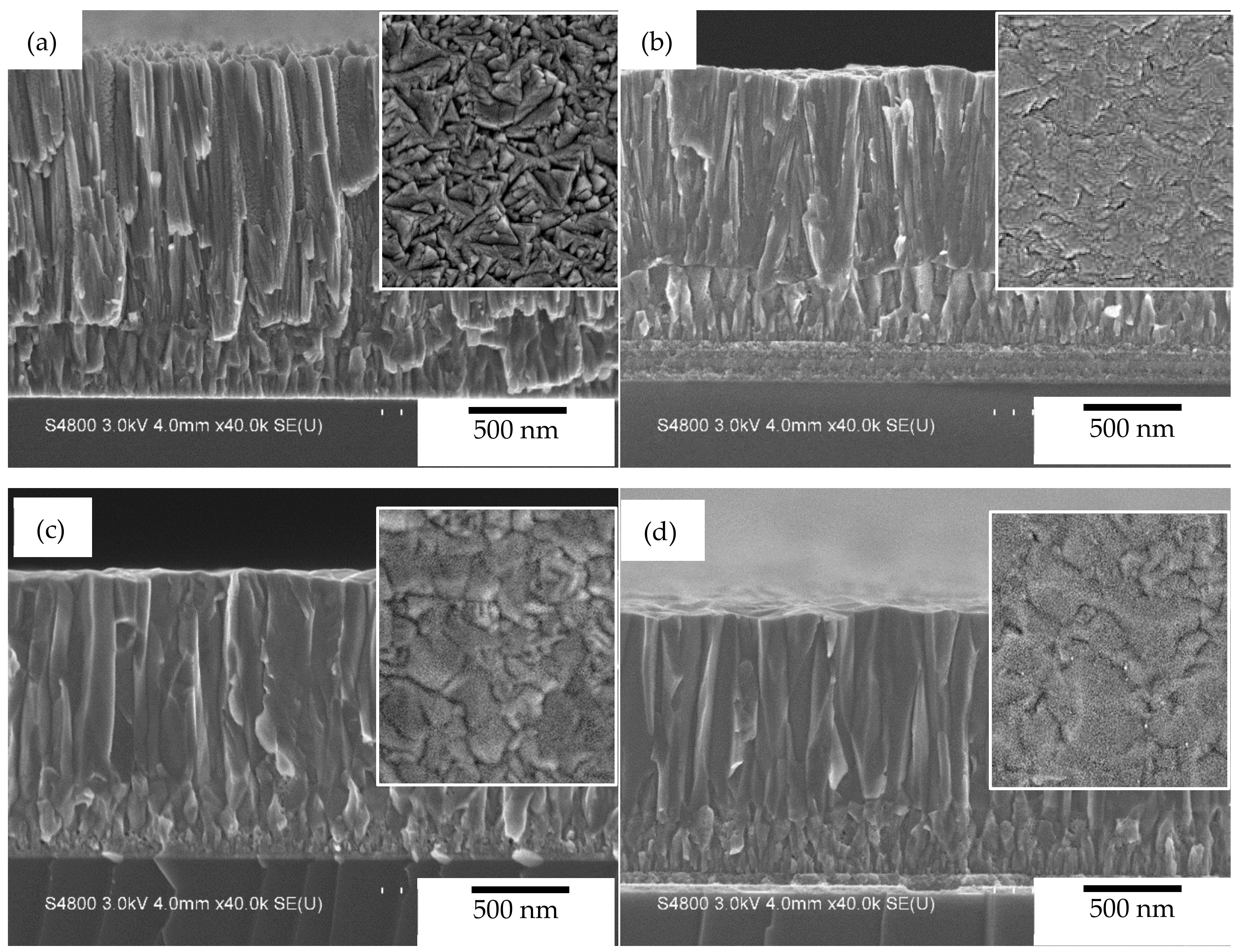Effects of Cathode Voltage Pulse Width in High Power Impulse Magnetron Sputtering on the Deposited Chromium Thin Films
Abstract
1. Introduction
2. Materials and Methods
3. Results and Discussion
3.1. Effects of the Deposition Pressure and the HiPIMS Pulse Width on the Cr Film Structure
3.2. Effects of Synchronized Pulse Substrate Bias and the HiPIMS Pulse Width on the Cr Film Structure
4. Conclusions
Author Contributions
Funding
Acknowledgments
Conflicts of Interest
References
- Bikulčius, G.; Češunienė, A.; Selskienė, A.; Pakštas, V.; Matijošius, T. Dry sliding tribological behavior of Cr coatings electrodeposited in trivalent chromium sulphate baths. Surf. Coat. Technol. 2017, 315, 130–138. [Google Scholar] [CrossRef]
- Daure, J.L.; Carrington, M.J.; Shipway, P.H.; McCartney, D.G.; Stewart, D.A. A comparison of the galling wear behaviour of PVD Cr and electroplated hard Cr thin films. Surf. Coat. Technol. 2018, 350, 40–47. [Google Scholar] [CrossRef]
- Navinšek, B.; Panjan, P.; Milošev, I. PVD coatings as an environmentally clean alternative to electroplating and electroless processes. Surf. Coat. Technol. 1999, 116, 476–487. [Google Scholar] [CrossRef]
- Vergason, G.; Fitch, M.; Smith, R.; Brazil, M.; Jochum, T. PVD chromium coatings replacing decorative chromium electroplated coatings on plastics. In Proceedings of the 58th Annual Technical Conference Proceedings, Santa Clara, CA, USA, 25–30 April 2015. [Google Scholar] [CrossRef]
- Li, B.; Gali, O.A.A.; Shafiei, M.M.; Hunter, J.A.; Riahi, A.R. Aluminum transfer buildup on PVD coated work rolls during thermomechanical processing. Surf. Coat. Technol. 2016, 308, 244–255. [Google Scholar] [CrossRef]
- Merij, A.C.; Sugahara, T.; Martins, G.V.; Sobrinho, A.S.D.; Reis, D.A.P.; Goncalves, P.A.R.; Massi, M. Use of Cr interlayer to promote the adhesion of SiC films deposited on Ti–6Al–4V by HiPIMS. Mater. Res. 2015, 18, 904–907. [Google Scholar] [CrossRef]
- Lattemann, M.; Ehiasarian, A.P.; Bohlmark, J.; Persson, P.Å.O.; Helmersson, U. Investigation of high power impulse magnetron sputtering pretreated interfaces for adhesion enhancement of hard coatings on steel. Surf. Coat. Technol. 2006, 200, 6495–6499. [Google Scholar] [CrossRef]
- Lundin, D.; Minea, T.; Gudmundsson, J.T. High Power Impulse Magnetron Sputtering: Fundamentals, Technologies, Challenges and Applications; Elsevier: Amsterdam, The Netherlands, 2019; ISBN 9780128124543. [Google Scholar]
- Anders, A. Tutorial: Reactive high power impulse magnetron sputtering (R-HiPIMS). J. Appl. Phys. 2017, 121, 171101. [Google Scholar] [CrossRef]
- Kouznetsov, V.; Macak, K.; Schneider, J.; Helmersson, U.; Petrov, I. Hybrid HIPIMS and DC magnetron sputtering deposition of TiN coatings: Deposition rate, structure and tribological properties. Surf. Coat. Technol. 1999, 12, 290. [Google Scholar] [CrossRef]
- Machunze, R.; Ehiasarian, A.; Tichelaar, F.; Janssen, G.; Ehiasarian, A. Stress and texture in HIPIMS TiN thin films. Thin Solid Films 2009, 518, 1561–1565. [Google Scholar] [CrossRef]
- Bugaev, S.P.; Sochugov, N.S. Production of large-area coatings on glasses and plastics. Surf. Coat. Technol. 2000, 131, 474–480. [Google Scholar] [CrossRef]
- Greczynski, G.; Lu, J.; Jensen, J.; Bolz, S.; Kölker, W.; Schiffers, C.; Lemmer, O.; Greene, J.E.; Hultman, L. A review of metal-ion-flux-controlled growth of metastable TiAlN by HIPIMS/DCMS co-sputtering. Surf. Coat. Technol. 2014, 257, 15–25. [Google Scholar] [CrossRef]
- Zuo, X.X.; Ke, P.P.; Chen, R.; Li, X.; Odén, M.; Wang, A. Discharge state transition and cathode fall thickness evolution during chromium HiPIMS discharge. Phys. Plasmas 2017, 24, 083507. [Google Scholar] [CrossRef]
- Anders, A.; Andersson, J.; Ehiasarian, A. High power impulse magnetron sputtering: Current-voltage-time characteristics indicate the onset of sustained self-sputtering. J. Appl. Phys. 2007, 102, 113303. [Google Scholar] [CrossRef]
- Greczynski, G.; Hultman, L. Time and energy resolved ion mass spectroscopy studies of the ion flux during high power pulsed magnetron sputtering of Cr in Ar and Ar/N2 atmospheres. Vacuum 2010, 84, 1159–1170. [Google Scholar] [CrossRef]
- Vetushka, A.; Ehiasarian, A.P. Plasma dynamic in chromium and titanium HIPIMS discharges. J. Phys. D Appl. Phys. 2008, 41, 015204. [Google Scholar] [CrossRef]
- Ferreira, F.; Serra, R.; Oliveira, J.C.; Cavaleiro, A. Effect of peak target power on the properties of Cr thin films sputtered by HiPIMS in deep oscillation magnetron sputtering (DOMS) mode. Surf. Coat. Technol. 2014, 258, 249–256. [Google Scholar] [CrossRef]
- Gudmundsson, J.T.; Alami, J.; Helmersson, U. Spatial and temporal behavior of the plasma parameters in a pulsed magnetron discharge. Surf. Coat. Technol. 2002, 161, 249–256. [Google Scholar] [CrossRef]
- Comite Europeen de Normalisation. Advanced Technical Ceramics—Methods of Test for Ceramic Coatings—Part 2: Determination of Coating Thickness by the Crater Grinding Method; EN 1071-2; Comite Europeen de Normalisation: Brussels, Belgium, 2002. [Google Scholar]
- Anders, A. A structure zone diagram including plasma-based deposition and ion etching. Thin Solid Films 2010, 518, 4087–4090. [Google Scholar] [CrossRef]
- Besnard, A.; Martin, N.; Millot, C.; Gavoille, J.; Salut, R. Effect of sputtering pressure on some properties of chromium thin films obliquely deposited. Mater. Sci. Eng. 2010, 12, 012015. [Google Scholar] [CrossRef]
- Wang, S.F.; Lin, H.C.; Bor, H.Y.; Tsai, Y.L.; Wei, C.N. Characterization of chromium thin films by sputter deposition. J. Alloys Compd. 2011, 509, 10110–10114. [Google Scholar] [CrossRef]
- Akbarnejad, E.; Soleimani, E.A.; Ghorannevis, Z. Chromium thin film deposition on ITO substrate by RF sputtering. J. Theor. Appl. Phys. 2014, 8, 129. [Google Scholar] [CrossRef]
- Kim, D.K.; Lee, K.S.; Yoon, Y.S. Effect of CrN barrier on fuel-clad chemical interaction. Nucl. Eng. Technol. 2018, 50, 724–730. [Google Scholar] [CrossRef]
- Gall, D.; Kodambaka, S.; Wall, M.A.; Petrov, I.; Greene, J.E. Pathways of atomistic processes on TiN (001) and (111) surfaces during film growth: An ab initio study. J. Appl. Phys. 2003, 93, 9086–9094. [Google Scholar] [CrossRef]
- Elmkhah, H.; Attarzadeh, F.; Fattah-alhosseini, A.; Kim, K.H. Microstructural and electrochemical comparison between TiN coatings deposited through HIPIMS and DCMS techniques. J. Alloy. Compd. 2018, 735, 422–429. [Google Scholar] [CrossRef]
- Alami, J.; Maric, Z.; Busch, H.; Klein, F.; Grabowy, U.; Kopnarski, M. Enhanced ionization sputtering: A concept for superior industrial coatings. Surf. Coat. Technol. 2014, 255, 43–51. [Google Scholar] [CrossRef]
- Mahieu, S.; Depla, D. Reactive sputter deposition of TiN layers: Modelling the growth by characterization of particle fluxes towards the substrate. J. Phys. D Appl. Phys. 2009, 42, 053002. [Google Scholar] [CrossRef]
- De Monteynard, A.; Schuster, F.; Billard, A.; Sanchette, F. Properties of chromium thin films deposited in a hollow cathode magnetron powered by pulsed DC or HiPIMS. Surf. Coat. Technol. 2017, 330, 241–248. [Google Scholar] [CrossRef]
- Greczynski, G.; Jensen, J.; Hultman, L. Mitigating the geometrical limitations of conventional sputtering by controlling the ion-to-neutral ratio during high power pulsed magnetron sputtering. Thin Solid Films 2011, 519, 6354–6361. [Google Scholar] [CrossRef]
- Lintymer, J.; Martin, N.; Chappé, J.-M.; Delobelle, P.; Takadoum, J. Nanoindentation of chromium zigzag thin films sputter deposited. Surf. Coat. Technol. 2005, 200, 269–272. [Google Scholar] [CrossRef]






| Deposition Parameters | Value | |
|---|---|---|
| Atmosphere | Argon pressure (Pa) | 0.8, 1.2 |
| HiPIMS power | Target average power (kW) | 3 |
| Target peak voltage (V) | −681~−588 | |
| Target peak current (A) | 259~154 | |
| Target pulse frequency (Hz) | 332, 81, 48 | |
| Target pulse width (μs) | 60, 200, 360 | |
| Target pulse duty cycle (%) | ~1.7 | |
| Substrate | Bias voltage (V) | dc −30 |
| Deposition temperature (°C) | 190~210 | |
| Deposition time (min) | 57~68 | |
| Deposition Parameters | Value | |
|---|---|---|
| Interlayer | Substrate bias | Synchronized pulse −1000 V, pulse width 1 ms |
| Duration (min) | 10 | |
| Top-layer | Substrate bias | Ground 0 V, synchronized pulse −200 V, pulse width 375 μs |
| Duration (min) | 11~18 | |
| Substrate Bias | Hardness (Mean ± Std. Dev.) | |
|---|---|---|
| Pulse Width 60 μs | Pulse Width 200 μs | |
| 0 V (grounded) | NA | 11,272 ± 2651 MPa |
| −200 V | 5292 ± 1415 MPa | 10,934 ± 1307 MPa |
© 2020 by the authors. Licensee MDPI, Basel, Switzerland. This article is an open access article distributed under the terms and conditions of the Creative Commons Attribution (CC BY) license (http://creativecommons.org/licenses/by/4.0/).
Share and Cite
Kuo, C.-C.; Lin, C.-H.; Lin, Y.-T.; Chang, J.-T. Effects of Cathode Voltage Pulse Width in High Power Impulse Magnetron Sputtering on the Deposited Chromium Thin Films. Coatings 2020, 10, 542. https://doi.org/10.3390/coatings10060542
Kuo C-C, Lin C-H, Lin Y-T, Chang J-T. Effects of Cathode Voltage Pulse Width in High Power Impulse Magnetron Sputtering on the Deposited Chromium Thin Films. Coatings. 2020; 10(6):542. https://doi.org/10.3390/coatings10060542
Chicago/Turabian StyleKuo, Chin-Chiuan, Chun-Hui Lin, Yu-Tse Lin, and Jing-Tang Chang. 2020. "Effects of Cathode Voltage Pulse Width in High Power Impulse Magnetron Sputtering on the Deposited Chromium Thin Films" Coatings 10, no. 6: 542. https://doi.org/10.3390/coatings10060542
APA StyleKuo, C.-C., Lin, C.-H., Lin, Y.-T., & Chang, J.-T. (2020). Effects of Cathode Voltage Pulse Width in High Power Impulse Magnetron Sputtering on the Deposited Chromium Thin Films. Coatings, 10(6), 542. https://doi.org/10.3390/coatings10060542




